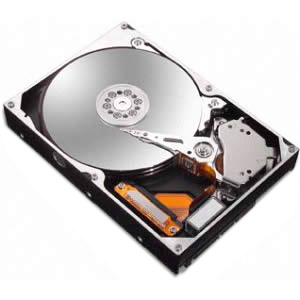Computer Hard disk :
The primary computer storage medium, which is made of one or more aluminum or glass platters, coated with a ferromagnetic material. Most hard disks are "fixed disks," which have platters that reside permanently in the drive. Almost all computers have an internal hard disk, and external units can be plugged in for additional storage or backup.
The primary computer storage medium, which is made of one or more aluminum or glass platters, coated with a ferromagnetic material. Most hard disks are "fixed disks," which have platters that reside permanently in the drive. Almost all computers have an internal hard disk, and external units can be plugged in for additional storage or backup.
The other type of hard disk is a "removable disk" encased in a cartridge, allowing data to be ejected from the drive for external storage or transfer to another party. Before high-speed Internet connections were common, removable SyQuest, Jaz and Zip cartridges were routinely shipped via the post office (see removable disk).
Three Major Categories: PATA, SATA and SCSI
Most hard disks are Parallel ATA (PATA), Serial ATA (SATA) or SCSI. SCSI drives have traditionally been found on servers and high-performance workstations and were the first drives used in fault-tolerant RAID systems. Today, ATA drives are widely used for RAID arrays. See IDE, PATA, SATA, SCSI and RAID.
Hard drives are low-level formatted at the factory, which records the original sector identification on the platters (see format program). See hard disk defect management.
Fast Rotation
Hard disks provide fast retrieval because they rotate constantly at high speed, from 5,000 to 15,000 RPM. Either to preserve battery life in laptops or to promote longevity, hard disks can be configured to turn off after a defined period of inactivity.
It Started in the Mid-1950s
In 1956, IBM introduced the RAMAC hard disk with platters two feet in diameter that held the equivalent of
Three Major Categories: PATA, SATA and SCSI
Most hard disks are Parallel ATA (PATA), Serial ATA (SATA) or SCSI. SCSI drives have traditionally been found on servers and high-performance workstations and were the first drives used in fault-tolerant RAID systems. Today, ATA drives are widely used for RAID arrays. See IDE, PATA, SATA, SCSI and RAID.
Hard drives are low-level formatted at the factory, which records the original sector identification on the platters (see format program). See hard disk defect management.
Fast Rotation
Hard disks provide fast retrieval because they rotate constantly at high speed, from 5,000 to 15,000 RPM. Either to preserve battery life in laptops or to promote longevity, hard disks can be configured to turn off after a defined period of inactivity.
It Started in the Mid-1950s
In 1956, IBM introduced the RAMAC hard disk with platters two feet in diameter that held the equivalent of
100,000 bytes. In the 1980s, desktop computer hard disks were introduced with 5MB using 5.25" platters (see ST506). Today's entry-level drives have at least 8,000 times more capacity. Platter size was reduced to 3.5" for desktops, 2.5" for laptops and 1" for handhelds. In 2004, Toshiba introduced the 0.85" drive (see below). See magnetic disk, floppy disk, Microdrive, drop protection and CAV.

